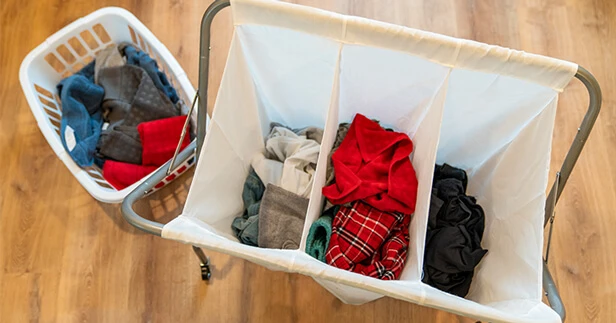How to Separate Laundry For Longer Lasting Clothes

If you're like most, you have a love-hate relationship with laundry—you love the idea of freshly laundered clothes but hate the mishaps that can ruin your most cherished items. The best way to avoid damage and help your clothes last longer is learning how to sort laundry properly and setting the correct temperature according to the fabric type and color.
How to Separate Laundry
There are a number of categories to consider when sorting your clothes, including:
1. Follow Care Instructions
Check the care label on new or unfamiliar items to determine whether the clothing can be machine washed and dried or if it requires hand washing or dry cleaning. Also note any special instructions regarding water temperature, use of bleach, and dryer temperature.
2. Know What Colors Can Be Washed Together
When it comes to separating colors, there are three main buckets: whites, light colors, and dark colors. Light colors include pastels, like your light blues, pinks, and khakis. Darks include those navy-blue sweaters and black sweatshirts. Jeans, especially dark washes, are often put in a class of their own.
Of all the dark colors, black tones transfer the easiest. So try to do all your dark-colored laundry at the same time. You may want to wash your whites separately too so you can use bleach. If not, it’s okay to wash whites and light colors together.
3. Sort by Fabric
After your laundry is sorted by color, go through each pile and sort it again by fabric and the garments’ weight. For example, wash light-colored bedding separate from blouses, underwear, and slacks, and be sure to keep lint-producing items, like towels, separated from those that attract lint, like wool sweaters. Keep items with zippers or rough surfaces separate from delicates.
4. Pay Attention to Soil Type
Heavily soiled items require pre-treating and should be laundered apart from other clothing to prevent dirt or oil transfer.
5. Set the Right Temperature
Traditional standards for laundry temperature are using cold water for dark colors, warm water for light colors, and hot water for whites.
Why You Should Sort Your Laundry
If you're short on time or energy, you may be tempted to toss all your clothes into the same wash cycle, but here are several reasons the laundry sorting process is beneficial:
- Cleaner clothes. Separating heavily soiled, stained, or grease-laden items from delicate or moderately soiled clothing helps prevent half clean or stained clothes after washing.
- Minimal color bleeding. By knowing how to sort laundry properly, you can eliminate color transfer between bright clothing and light-colored items.
- Less wear and tear. Damage can occur from friction from buttons, zippers, and heavy fabrics. Sorting helps you avoid that problem.
- Less lint transfer. Tossing your bath towels in with cotton shirts, jeans, or other items can result in an unsightly abundance of lint.
Laundry Tips and Tricks
- A well-organized laundry room can help make this chore a breeze.
- Catch stains as they happen, and begin pre-treating before they have a chance to set.
- Reduce fading by turning dark-colored items inside out before throwing them into the wash.
- Avoid overloading your machine, which can lead to substandard cleaning and damage to fabrics.
- Remove clothing from the dryer as soon as the cycle is complete to reduce wrinkling and time spent ironing.
- Check out our guides to washing machine maintenance and dryer maintenance.
- Use mesh washing bags to protect delicate items and keep socks or other paired items together.
Ensure the reliable, efficient performance of your washing machine by taking care of it. Whenever you have appliance maintenance and repair needs, connect with your local Mr. Appliance experts or schedule service online.
 Click to call
Click to call


